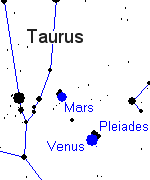
Image credit: NASA
The Pleiades are elusive. You rarely find them on purpose. They’re best seen out of the corner of your eye, a pretty little surprise that pops out of the night sky when you’re staring elsewhere.
Venus is just the opposite. Dazzling, bright enough to cast faint shadows, it beams down from the heavens and grabs you, mesmerizing. You can’t take your eyes off it.
This weekend, Venus and the Pleiades are coming together. It happens every 8 years: Venus glides through the Pleiades star cluster and, while dissimilar things don’t always go well together, these do. It’s going to be a beautiful ensemble.
Step outside after dark on Thursday, April 1st and look west. Venus is the improbably-bright “star” about halfway up the sky. Just above Venus lies the Pleiades, often mistaken for the Little Dipper because the faint stars of the Pleiades trace the shape of ? a little dipper.
If you go outside and look several nights in a row, you can see how fast Venus travels across the sky. On Friday, April 2nd, Venus enters the Pleiades, just below the dipper’s bowl. On Saturday, April 3rd, Venus scoots upward to join the stars in the dipper’s handle. On Sunday, April 4th, Venus exits the cluster altogether. Compared to what you saw on April 1st, the two have switched places.
Here are a few things to think about while you’re watching the show:
The Pleiades are a clutch of baby stars. They formed barely 100 million years ago, during the age of dinosaurs on Earth, from a collapsing cloud of interstellar gas. The biggest and brightest of the cluster are blue-white and about five times wider than our own sun.
The Pleiades didn’t exist when Venus first emerged from the protosolar nebula 4.5 billion years ago. No one knows what Venus was like in those early days of the solar system. It might have been lush, verdant, Earth-like. Today, though, it’s hellish. A runaway greenhouse effect on Venus has super-heated the planet to nearly 900? F, hot enough to melt lead. Dense gray clouds laced with sulfuric acid completely hide Venus’ surface from telescopes on Earth. The smothering clouds, it turns out, are excellent reflectors of sunlight, and that’s why Venus looks so bright.
As seen from Earth, Venus shines about 600 times brighter than Alcyone, the most luminous star in the Pleiades. During the weekend try scanning the group with binoculars. You’ll see dozens of faint Pleiades invisible to the unaided eye. Among them, bright Venus looks like a supernova.
But, really, it’s just an ancient planet gliding in front of some baby stars–a dissimilar ensemble that you won’t want to miss.
Original Source: NASA Science
